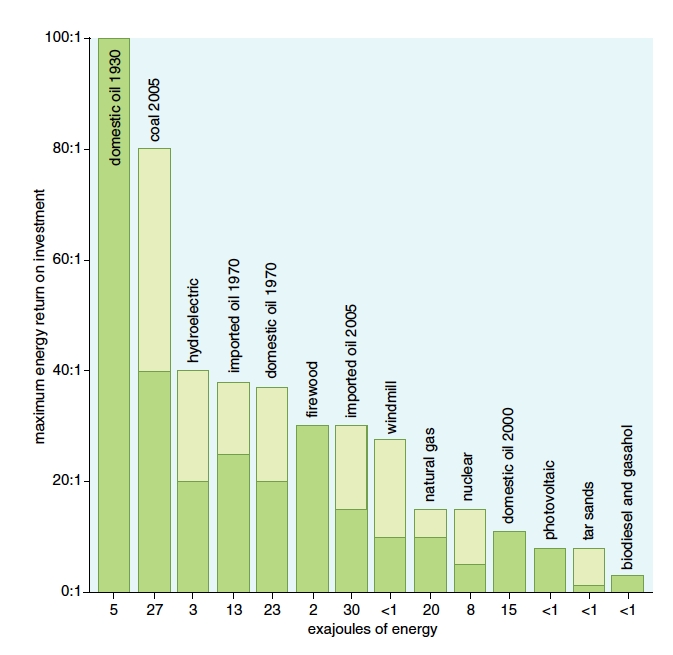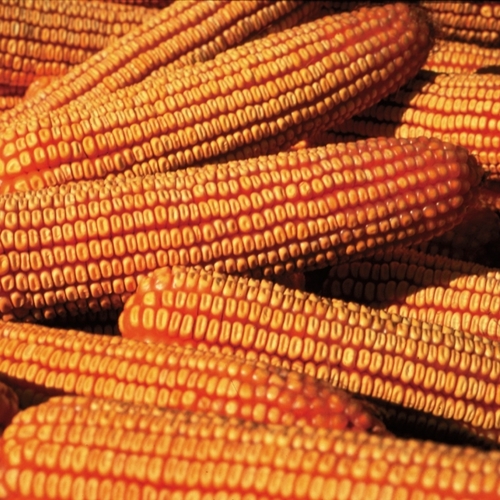
Image Credit: American Scientist
For the past few weeks, I’ve been writing about petroleum: what it is, the history of petroleum use, and what’s ahead for this ubiquitous energy source that, to a significant extent, defines our society. This week, I’ll cover a method of evaluating not only petroleum, but other energy sources as well: “energy return on investment.”
Energy return on investment (EROI), sometimes referred to as “energy return on energy invested” or “net energy analysis,” is the energy cost of acquiring a particular energy resource. Mathematically, it is the ratio of the amount of usable energy acquired from a particular resource to the energy expended to acquire that energy.
The higher the EROI, the more “profitable” the energy resource (from an energy standpoint). If the EROI drops below 1:1, it means that it takes more energy to produce the usable energy than is contained in the finished product.
The significance of this sort of analysis becomes clear when we look at different energy sources through the lens of EROI. In a May-June 2009 article in American Scientist, professors Charles Hall of the State University of New York – Syracuse and John Day of Louisiana State University reported that in 1930 domestic oil production in the U.S. had an EROI of 100:1 (100 units of energy derived for each 1 unit of oil-equivalent expended to produce it).
By 1970, with our deeper wells and greater energy expenditures for pumping and processing the oil, the EROI of domestic oil had fallen to 40:1. Today U.S. oil is produced at an EROI of about 14:1, according to Hall and Day. The EROI for Athabascan tar sands in Alberta, from which a million barrels per day of oil is now being produced, is just 6:1, according to Canadian petroleum geologist David Hughes (as quoted in the January 7, 2011 issue of The Walrus).
Approximate EROI values for some other energy sources, according to Hall and Day, include coal 80:1, hydroelectric power 40:1, firewood 30:1, wind power 28:1, natural gas and nuclear power 18:1, and photovoltaics 8:1 (see chart from American Scientist).
When we have to invest almost as much fossil fuel in an energy source as that energy source provides, we have to rethink the wisdom of investing in it. That’s the case with corn-ethanol today, which — depending on whose estimates you believe — has an EROI between 0.8:1 and 1.5:1. In other words, for every one unit of fossil fuel energy invested (growing corn and converting it into ethanol) you end up with between 0.8 and 1.5 units of ethanol produced [this sentence reflects correction from original wording — see comment below]; at the worst-case estimate, we invest more energy in producing ethanol than the finished product contains. This is why a lot of experts — not only environmentalists but also economists — are questioning the wisdom of spending billions of taxpayer money each year to prop up the corn-ethanol industry.
There are situations in which investing in energy resources with very low EROI values can make sense — for example, if most of that energy investment is front-loaded and the subsequent operating energy requirements are relatively low. This is the case with solar water heating. It takes a lot of energy to produce copper absorber plates, piping, and other solar collector components — but most of those energy inputs are “upstream” (that is, they have already been expended by the time your solar water heating system is hooked up).
It can make good economic sense for an individual — or a society — to invest in that energy producing system as long as the ongoing energy input is renewable (sunlight, wind, or wave power, for example) and as long as the system can be maintained and operated for a long time.
As we debate our future energy choices and policies, energy return on investment should be an important part of the discussion. Such analysis gives us a “reality check” as we figure out where to put our energy investments — and which energy technologies our government should subsidize. Such an analysis would likely put a stop to the pork-barrel subsidies going into corn-derived ethanol.
In addition to this Energy Solutions blog, Alex contributes to the weekly blog BuildingGreen’s Product of the Week, which profiles an interesting new green building product each week. You can sign up to receive notices of those blogs by e-mail — enter your e-mail address in the upper right corner of any BuildingGreen blog page.
Alex is founder of BuildingGreen, Inc. and executive editor of Environmental Building News. To keep up with his latest articles and musings, you can sign up for his Twitter feed.
Weekly Newsletter
Get building science and energy efficiency advice, plus special offers, in your inbox.















21 Comments
Correction, though your conclusion is still right.
Alex, I believe you have this reversed. It should be: One unit of invested energy results in .8 and 1.5 units of ethanol. "That's the case with corn-ethanol today, which — depending on whose estimates you believe — has an EROI between 0.8:1 and 1.5:1. In other words, it takes between 0.8 and 1.5 units of fossil fuel energy (growing corn and converting it into ethanol) to produce one unit of ethanol produced from corn; at the worst-case estimate, we invest more energy in producing ethanol than the finished product contains.
You're absolutely right, Jim
Thanks for the catch! I've corrected the blog.
ROI
Alex,
Notwithstanding the energy implications, products like ethanol (not including cellulose-based ethanol) have other social, environmental and economic implications. A gallon of Corn ethanol takes upwards of 30 gallons of water to produce and raises the price of the food grain beyond the means of some consumers, either because it makes corn more expensive or deflects corn from animal feedstock.
It is going to be increasingly important for us to evaluate the total impacts of our fuels and material decisions, perhaps using a comprehensive Life Cycle assessment tool as well as point of extraction impact evaluation tools. Until that occurs, we may end up making well-intentioned but naive decisions which will only be recognized through generational hindsight.
And while our technology may help us reduce our impact in fuel production, maybe we should consider simple approaches like wearing a sweater or riding a bike instead of technological ones like PVs and hybrid vehicles.
Growing corn
To follow up on Peter's post, why feed corn to livestock? Growing corn to feed cattle is a terrible waste of fuel and topsoil, cattle are by nature, grazing animals. Let livestock feed naturally on grassland, this is sustainable.
Couldn't agree more.
Yes.
I find that most people are content to end their understanding of energy consumption with the "operational" aspects of a home.
"Net-Zero" springs to mind. As admirable a goal as "Net-Zero" may be, it makes no attempt to describe the externalized energy consumption (embodied energy in materials, infrastructure, construction and transportation etc.) that is - like it or not - part of the process of creating a "Net-Zero" house.
An adaptation of the EROEI concept could be a very valuable tool in directly evaluating the conservation of energy resources in a building project. Detailed life-cycle data would be a critical component of such an evaluation.
Such a tool might also be used as a means of determining whether there is any "net energy benefit" to adding say, another 6 inches of XPS under a slab or whether there is any "net energy benefit" to installing 10kW of PV over simply having 1kW for some personal energy security.
I think this is wise. As I said, we externalize far too much of our energy use and that leads to misconceptions. It's time to start taking responsibility for those externalities which means (like it or not) figuring out how to get by on less.
Is life a cost-benefit investment-return equation?
We can quibble about the relative return on investment of various energy sources, but the only sustainable way of life is to live within the earth's daily allotment of solar energy, captured and converted by the original solar technology: green plants. This truly green technology kept the biosphere in balance for 3.5 billion years, but in a blink of an eye we have unbalanced earth's energy economy and come close to destroying what may be the only living planet in the universe.
Good point.
Green plants have the best EROEI around (as long as we aren't forcing them to grow by applying energy inputs in the form of fertilizers).
There is no more efficent way of converting solar energy.
Cellulosic ethanol
I posted this under your "Thoughts on the future of oil" blog, but thought it might be appropriate here, as well. An excellent article on potential alternative, non-food based fuels.
http://green.blogs.nytimes.com/2011/01/13/a-step-toward-car-fuel-from-wood-waste/?partner=rss&emc=rss
As for Doug's concern about feeding corn to cattle, the bulk of corn fed is not the grain, but the stalks and leaves which get mulched and fermented. However, I do agree -- feeding high quality cornmeal to animals is a poor way to convert the suns energy to food for humans.
Reply to Peter
Visit any Midwest feedmill and you will see no cornstalks but you will see a lot of ground corn. Cornstalks are used for bedding as there is no grain straw when you only grow corn and soybeans. Corn is used primarily as animal feed, plain and simple.
On using cornstalks as livestock feed
Doug,
Local practices vary. Here in Vermont, farmers harvest all of the above-ground portions of the corn plant, including stalks and leaves, and use it (usually in the form of silage) to feed dairy cattle during the winter.
Silage is universal
Yes, I know about silage which includes the corn (grain) as part of the mixture. But to say livestock in general is fed cornstalks and the corn grain is used elsewhere is false.
Interestingly, silage these days is not stored in silos as much as large, airtight tubes or tightly covered piles above ground.
Tipsy Cows
And that silage is fermented for ease of digestion. So those lucky dairy cows are gettin' lickered up all winter.
Waste Not Want Not
Cellulosic plant or wood "waste" is no more the answer to fueling our automobile habit than corn ethanol.
Just as the current corn ethanol market (subsidized by Uncle Sam) has grown to the extent that it impacts world food prices, as soon as "wood waste" ethanol production accelerates we'll see producers using whole-tree harvesting for converting bio-diverse forests into wastelands.
We don't need more "alternative" fuels. We need fewer vehicles and a more human-scaled communities that encourage walking or bicycling, with trains for long-distance transportation.
Of course, they'll have to rip my Pickup Truck out of my cold, dead hands;-)
That darn lignin
Lignin is the stubborn compound that keeps cornstalks from breaking down and the viability of cellulosic ethanol out of reach. About 25 years ago there was a breakthrough at one of the universities where agricutural "waste", straw and other crop residues were treated with a mild hydrogen peroxide solution. The researchers claimed this process broke down the lignin, making the residue very palatable and nutritious for livestock. In fact they claimed corn could be replaced as a feedstock for animals as they gained as much or more weight on the treated crop residue ration. This "breakthrough" never really saw the light of day and corn remains "King".
A scene from the prairie, Giant sunflower (Helianthus giganteus)
Your current series of articles
Alex,
These artuicles on the OTHER Inconvenient Truth are so necessary at this point in time to bring our focus to the WHY we need to build more energy-efficiently. In speaking with builders, code officials and others in my job, it keeps comign out that they really aren't aware of the issues! They seem to think this is some way to jack up the price of housing! I kid you not! Keep up with these article- they are great. Brice
ERI Numbers
Alex. The 100:1 ratio in the 1930s was the benefit of little government regulation. I wonder how much of the decrease to today's 40:1 can be attributed to EPA, OSHA and other Federal and State regulations? IF LCA is used I assume regulatory costs are factored in as well. This will provide true numbers in my opinion.
EROI numbers
Bruce,
Regulations and environmental safeguards may contribute to the significantly lower EROI today (more like 14:1 instead of 40:1 that you note), but I think the very high EROI in 1930 had more to do with the fact that the crude oil "gushed" to the surface with little help from us (pumping and such). We just had to capture it (most of it anyway) and pipe it to where we needed it.
energy inputs
Alex,
For photovoltaics, are they calculating the ratio of solar energy input to usable electrical energy output? If that's the case, PV with a low EROI could be "better" than a fossil fuel with a higher EROI.
As an aside, it's nice to see proper SI units (exajoules) being used here.
EROI
As always a valuable post-thank you.
What would be the EROI on the following? Just a thought-
1. Walking. i.e.Energy on food,cooking, shoes, pavement etc compared to the bulk of a person and the distance travelled. The more you walked the better the EROI and the smaller the belly.
2. Running
3. Cycling
4. Riding a horse.
5. Using a rickshaw.
6. Drag racing.-negative return.
Are EROIs everywhere? The EROI does not factor in what you are doing with the energy. Could there be an EROI function that related to the end use of the energy? Am I just being weird?Cheers Mike
front loaded?
Alex, you say that a low EROI makes sense if the energy investment is "front-loaded". What difference does this make? This assumes the investment will go up over time? Isn't drilling for oil and natural gas front-loaded?--that is, large investment up front, relatively low operating cost over time. In fact, wouldn't small incremental costs over time be better than front loaded? What if you bread horses and used them to get around. You would be spending smaller amounts of money over time to feed them and shelter them. It seems like ROI is less important than renewable/non-renewable?
Front-loaded
Dave,
What I meant by the front-loaded statement was that I don't worry as much about a low EROI if once that energy is invested there is ongoing energy production from renewable energy. In making a PV module, for example, once you've invested that energy, sunlight contributes the rest. Perhaps there's a better way to say this, but that's what I had meant.
Log in or create an account to post a comment.
Sign up Log in